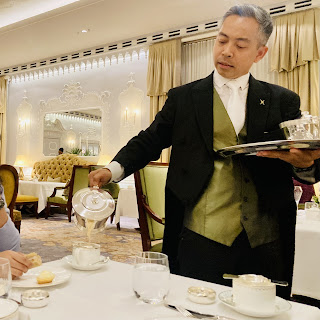English afternoon tea
The quaint English tradition of afternoon tea
According to legend, Anna Maria Russell, Duchess of Bedford, a lifelong friend of Queen Victoria, would get hungry around 4 PM. It was a long time to wait for dinner after an early lunch. So, she would ask for some tea and sandwiches (invented earlier by the English politician John Montagu, a.k.a. the 4th Earl of Sandwich ). Soon, that became her small ritual, and she started to ask her friends to join her at her little tea parties - starting the tradition of afternoon tea.
Traditional afternoon tea consists of a selection of dainty sandwiches (our selection included Severn & Wye smoked salmon with brown shrimp and rock samphire on rye bread; Cucumber, dill and horseradish on white bread; Roast chicken, gem lettuce and lemon thyme mayonnaise on malt bread; Cacklebean egg with mayonnaise, mustard and cress on white bread; and finally Dorrington ham with truffle and parmesan on onion bread), scones served with clotted cream, lemon curd and strawberry preserve. Cakes and pastries are also served.
Tea grown from all over the world is daintily poured from silver tea pots into delicate bone china cups. I decided to try the Japanese matcha tea from the garden of the renowned Hattori family with its distinct character and lime green colour. It has a subtle grassy scent with earthy undertones, and a velvety, slightly bitter finish. The last sip is intense, thick and creamy.
Today, the English afternoon tea ritual has became more of a special occasion to meet with family and friends, and celebrate special life events.
Clotted cream is a traditional British topping that originated in England. It is a smooth, yellow cream that is very thick and indulgent. The dish is traditionally made with full-fat (55% fat) unpasteurized cow's milk. The milk or cream is heated in a shallow pan for many hours until the cream rises to the surface and thickens or clots (hence the name). This thickened cream is skimmed off the top and is served with scones, at afternoon teas. It has a mildly sweet flavor often described as having a nutty, cooked milk taste.
Lemon curd is a probably best known for serving with scones at afternoon tea. The first written mention of lemon curd appears in England in 1844, which describes it simply as lemon juice added to cream to form curds. The curds were then be separated from the whey through cheesecloth. Although still called lemon curd, today’s recipe evolved to a velvety custard spread, made with by the combination of lemon, sugar, eggs and butter.
Here’s to more afternoons of leisurely high tea!








Comments
Post a Comment
Please keep conversations courteous and on-topic. Kindly don’t engage in trolling, flame-baiting, name-calling, insulting, stereotyping or gratuitous attacks. Thank you for being a good citizen.